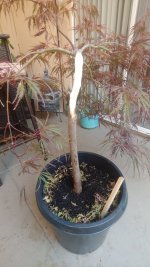Ctorres
Seed
I picked up this grafted Crimson Queen for half price in the hopes that I could air layer the CQ off the rootstock, train the rootstock as a bonsai, and maybe use the CQ as a landscaping tree. I have lots of questions and I've never tried air layering or grafting.
What would you do if this was your tree?
All advice is greatly appreciated as I'm still pretty new to this, Thank you!
- Would it be worth trying to remove the damaged trunk area and regraft the cq onto the rootstock then air layer it off or should I just air layer the rootstock below the CQ graft and leave the damaged portion of the cq trunk?
- What would be the best time to start air layering and then trunk chopping in zone 10b? I've read some contradicting things in books.
- Do you think the cq has enough remaining foliage to air layer successfully?
- If I air layer and chop off all the branches/foliage and leave the rootstock bare, would the rootstock have a lower chance of surviving than if I were to try to get it to back bud first somehow? Or would new shoots on the rootstock weaken the grafted CQ?
- Would you chop the rootstock just below the graft or lower to try to get taper and movement in the future?
- Would cut paste or anything else help the tree at this point? The break looks like it happened days before I got it.
- Should just let it recover for a year or two before attempting any work?
What would you do if this was your tree?
All advice is greatly appreciated as I'm still pretty new to this, Thank you!






